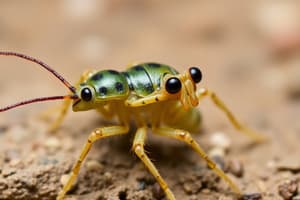Podcast
Questions and Answers
What disease is caused by Trypanosoma brucei gambiense?
What disease is caused by Trypanosoma brucei gambiense?
- Malaria
- Leishmaniasis
- Balantidiasis
- African sleeping sickness (correct)
Which mosquito is the definitive host for Plasmodium species?
Which mosquito is the definitive host for Plasmodium species?
- Culex mosquito
- Aedes mosquito
- Anopheles mosquito (correct)
- Mansonia mosquito
What is the only known human pathogen in the Phylum Ciliophora?
What is the only known human pathogen in the Phylum Ciliophora?
- Naegleria fowleri
- Entamoeba histolytica
- Giardia lamblia
- Balantidium coli (correct)
How does paramecium primarily obtain food?
How does paramecium primarily obtain food?
What type of reproduction does paramecium use to exchange genetic material?
What type of reproduction does paramecium use to exchange genetic material?
What defines invertebrates?
What defines invertebrates?
Which phylum includes organisms like sponges?
Which phylum includes organisms like sponges?
Which of the following is considered a higher invertebrate?
Which of the following is considered a higher invertebrate?
What stage is referred to as a vegetative stage in protozoans?
What stage is referred to as a vegetative stage in protozoans?
Which characteristic is NOT true for protozoans?
Which characteristic is NOT true for protozoans?
What term describes unicellular, heterotrophic, eukaryotic organisms?
What term describes unicellular, heterotrophic, eukaryotic organisms?
Which of the following groups is known for their simple body organization?
Which of the following groups is known for their simple body organization?
In which group are most protozoans found?
In which group are most protozoans found?
What structure do some protozoa use for locomotion that resembles a whip-like tail?
What structure do some protozoa use for locomotion that resembles a whip-like tail?
How do parasitic protozoa obtain nutrients from their hosts?
How do parasitic protozoa obtain nutrients from their hosts?
Which of the following subphyla uses pseudopodia for movement and nourishment?
Which of the following subphyla uses pseudopodia for movement and nourishment?
What is the process called where pseudopodia surround and engulf food particles?
What is the process called where pseudopodia surround and engulf food particles?
Which of the following protozoa is associated with causing dysentery?
Which of the following protozoa is associated with causing dysentery?
What type of nutrition do most protozoa primarily exhibit?
What type of nutrition do most protozoa primarily exhibit?
In which environment do amoebas typically thrive?
In which environment do amoebas typically thrive?
What is the primary method of asexual reproduction in protozoa?
What is the primary method of asexual reproduction in protozoa?
Flashcards are hidden until you start studying
Study Notes
Invertebrate Overview
- Invertebrates lack a vertebral column, comprising approximately 90% of all known animal species.
- Categories include lower and higher invertebrates based on body organization and evolutionary development.
- Lower invertebrates: Protozoa, Porifera, Coelenterata, Platyhelminthes, Nematoda.
- Higher invertebrates: Annelida, Arthropoda, Mollusca, Echinodermata.
Kingdom: Protista
- Protists inhabit aquatic and terrestrial environments.
- Classified into 12 phyla, grouped mainly into plant-like, animal-like (protozoa), and fungal-like organisms.
Protozoa Characteristics
- Unicellular, heterotrophic, eukaryotic organisms, referred to as "first animals."
- Contains around 20,000 species, with a small number being pathogenic.
- Primarily free-living, found in water and soil; some are parasitic or symbiotic.
- Reproduce asexually through fission or budding; some can reproduce sexually.
Movement Mechanisms
- Cilia: Tiny hair-like structures for coordinated movement.
- Flagella: Whip-like tails that enable motion through wave actions.
- Pseudopodia: Extensions of cytoplasm acting like "false feet."
Nutrition and Digestion
- Most protozoa are heterotrophic aerobic organisms; some can grow anaerobically as parasites.
- Feed on algae, yeast, bacteria, and decaying organic matter.
- Digestion occurs in vacuoles, with waste eliminated through the plasma membrane or anal pores.
Classification of Protozoa
-
Phylum: Sarcomastigophora
- Subphylum: Sarcodina (amoebas moving by pseudopods).
- Entamoeba histolytica: Causes amoebic dysentery.
- Subphylum: Mastigophora (movement via flagella).
- Important pathogens include Trichomonas vaginalis (causes urinary infections) and Giardia lamblia (causes giardiasis).
- Subphylum: Sarcodina (amoebas moving by pseudopods).
-
Phylum: Apicomplexa (Sporozoa)
- Notable pathogens: Plasmodium spp., responsible for malaria.
- Transmitted by Anopheles mosquitoes, resulting in millions of deaths annually.
-
Phylum: Ciliophora
- Move and feed using cilia.
- Balantidium coli: The only known human pathogen causing intestinal infections.
- Paramecium: A common ciliate, primarily found in freshwater environments.
Paramecium Feeding and Reproduction
- Feeding takes place in a funnel-shaped gullet, where cilia aid in capturing food.
- Two methods of reproduction:
- Conjugation: Sexual reproduction with genetic exchange through a conjugation tube.
- Binary Fission: Asexual reproduction producing two identical daughter cells.
Studying That Suits You
Use AI to generate personalized quizzes and flashcards to suit your learning preferences.




